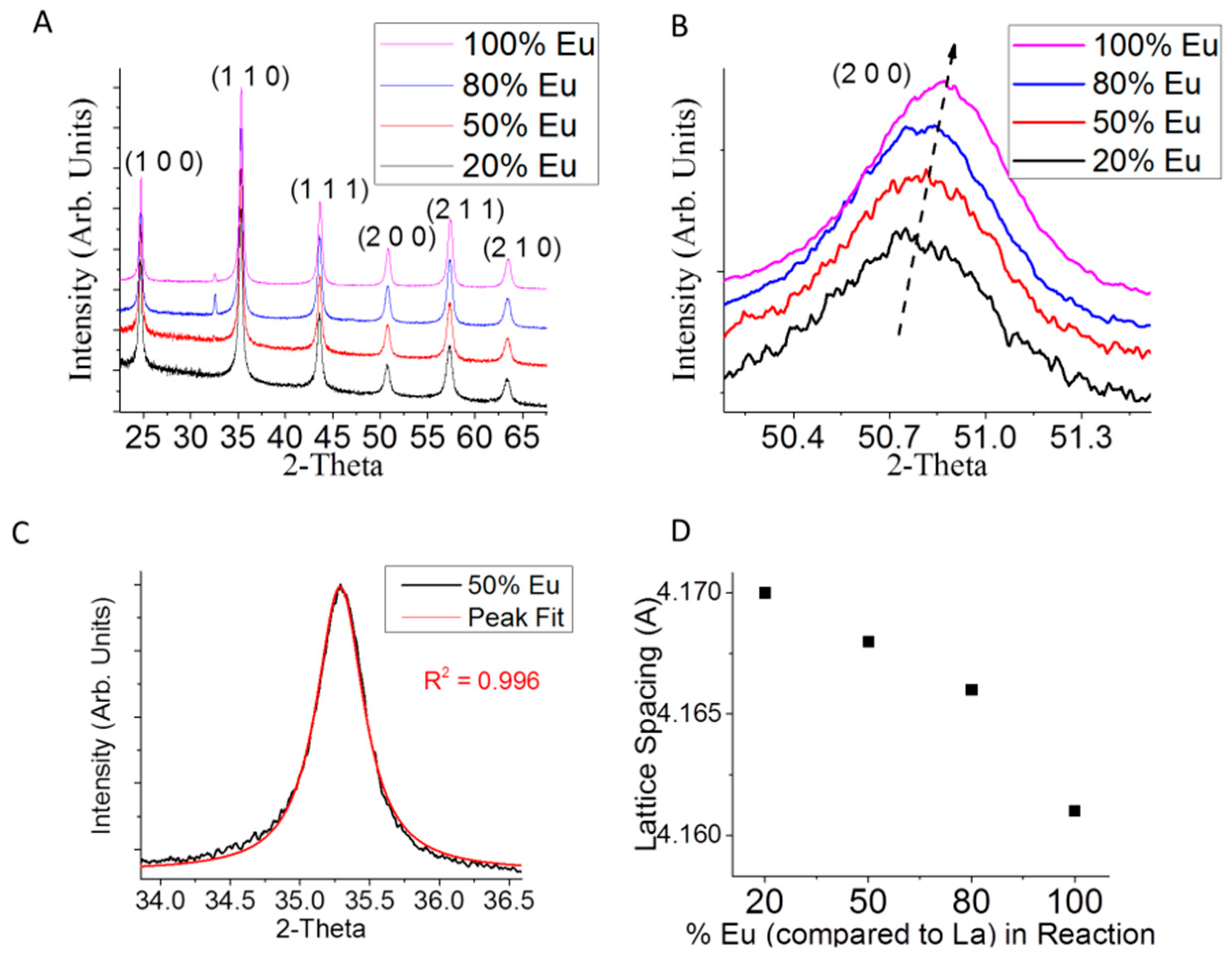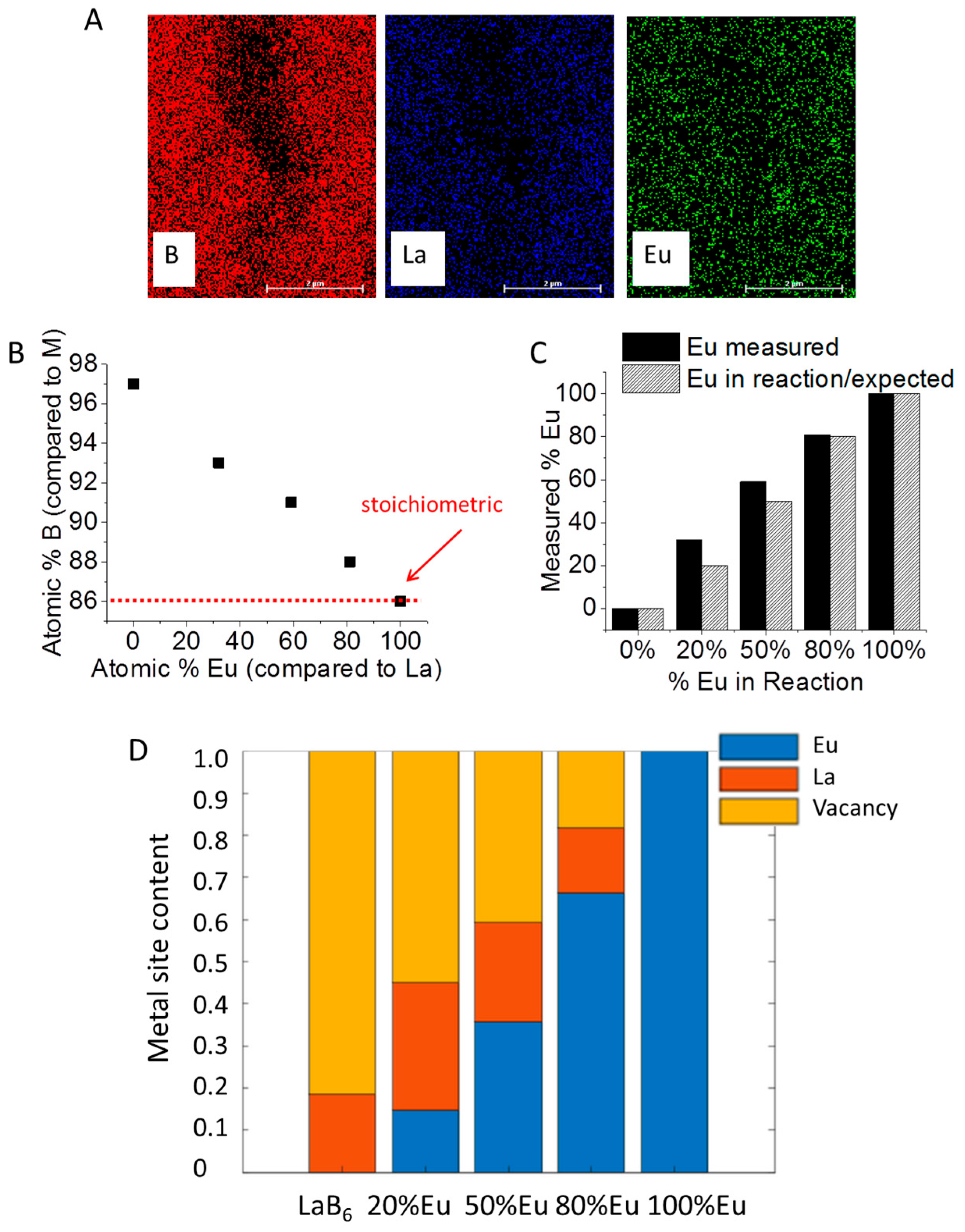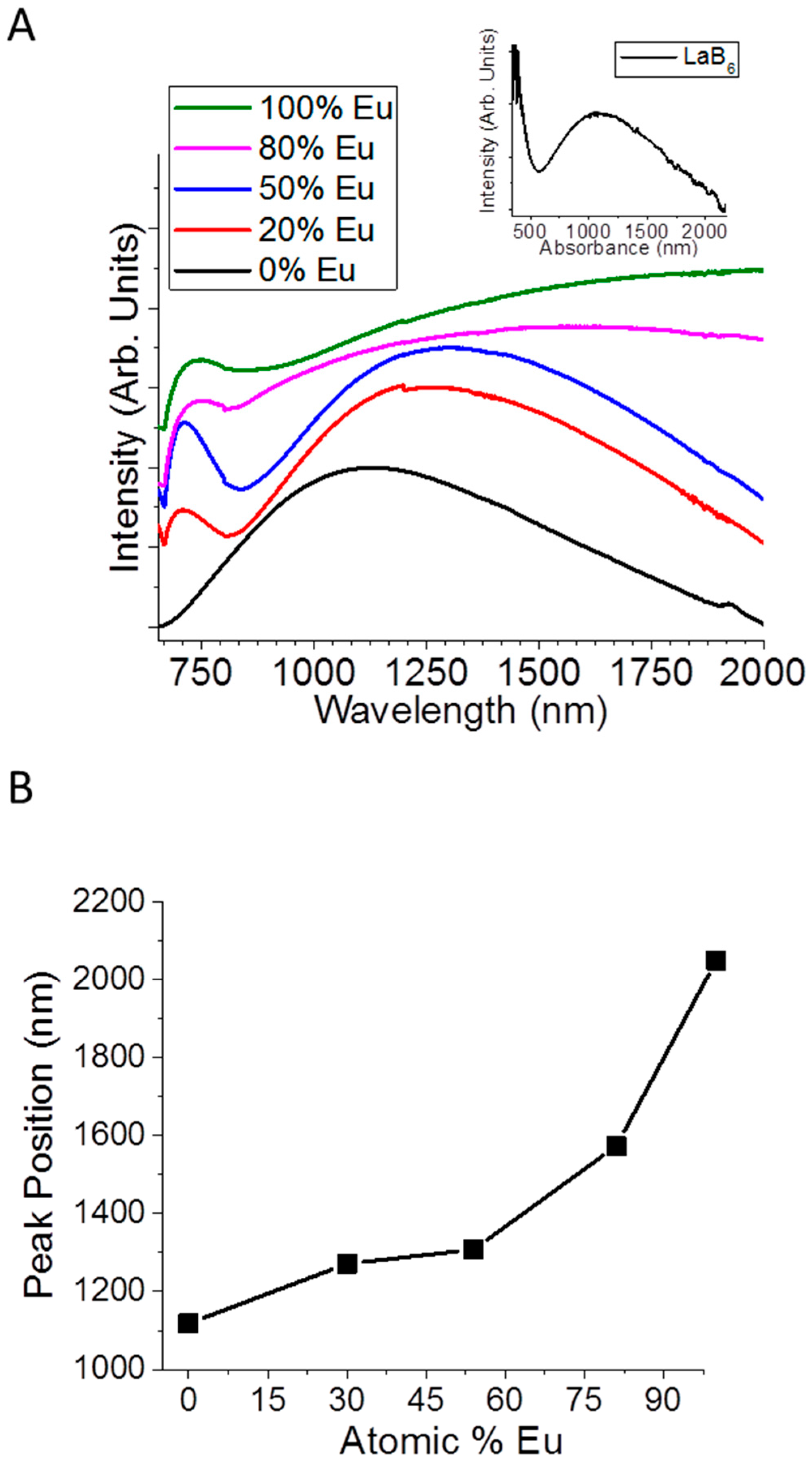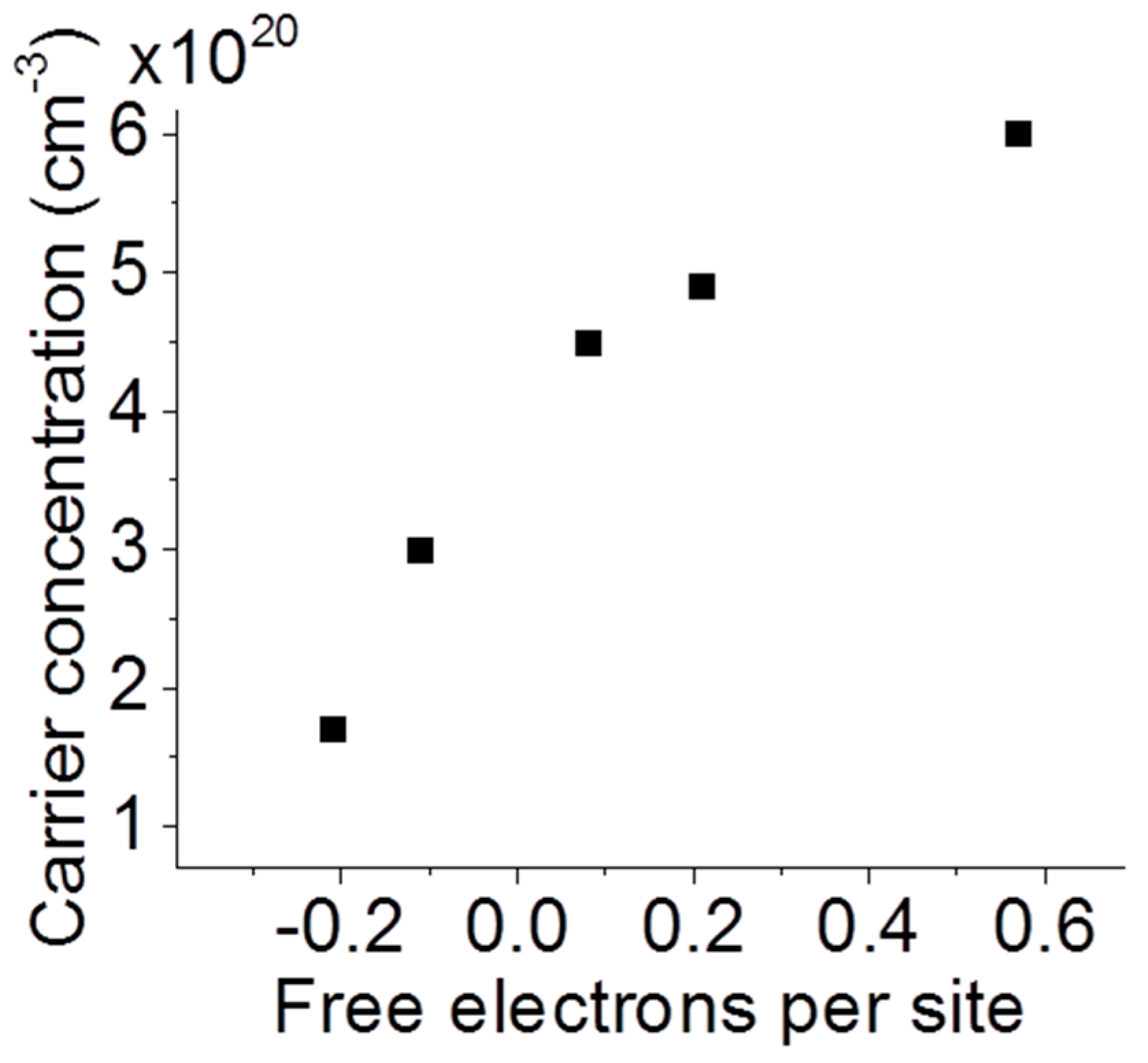Moving the Plasmon of LaB6 from IR to Near-IR via Eu-Doping
Abstract
:1. Introduction
2. Experimental Procedures
3. Results and Discussion
4. Conclusions
Acknowledgments
Author Contributions
Conflicts of Interest
References
- Mattox, T.M.; Ye, X.; Manthiram, K.; Schuck, P.J.; Alivisatos, A.P.; Urban, J.J. Chemical Control of Plasmons in Metal Chalcogenide and Metal Oxide Nanostructures. Adv. Mater. 2015, 27, 5830–5837. [Google Scholar] [CrossRef] [PubMed]
- Stockman, M.I. Nanoplasmonics: The physics behind the applications. Phys. Today 2011, 64, 39–44. [Google Scholar] [CrossRef]
- Anker, J.N.; Hall, W.P.; Lyandres, O.; Shah, N.C.; Zhao, J.; Duyne, R.P.V. Biosensing with plasmonic nanosensors. Nat. Mater. 2008, 7, 442. [Google Scholar] [CrossRef] [PubMed]
- Lopatynskyi, A.M.; Lytvyn, V.K.; Mogylnyi, I.V.; Rachkov, O.E.; Soldatkin, O.P.; Chegel, V.I. Smart nanocarriers for drug delivery: Controllable LSPR tuning. Semicond. Phys. Quantum Electron. Optoelectron. 2016, 19, 358–365. [Google Scholar] [CrossRef]
- Tame, M.S.; McEnery, K.R.; Özdemir, S.K.; Lee, J.; Maier, S.A.; Kim, M.S. Quantum plasmonics. Nat. Phys. 2013, 9, 329–340. [Google Scholar] [CrossRef]
- Elimelech, O.; Liu, J.; Plonka, A.M.; Frenkel, A.I.; Banin, U. Size Dependence of Doping by a Vacancy Formation Reaction in Copper Sulfide Nanocrystals. Angew. Chem. 2017, 129, 10471–10476. [Google Scholar] [CrossRef]
- Luther, J.M.; Jain, P.K.; Ewers, T.; Alivisatos, A.P. Localized surface plasmon resonances arising from free carriers in doped quantum dots. Nat. Mater. 2011, 10, 361. [Google Scholar] [CrossRef] [PubMed]
- Crockett, B.M.; Jansons, A.W.; Koskela, K.M.; Johnson, D.W.; Hutchison, J.E. Radial Dopant Placement for Tuning Plasmonic Properties in Metal Oxide Nanocrystals. ACS Nano 2017, 11, 7719–7728. [Google Scholar] [CrossRef] [PubMed]
- Kalanur, S.S.; Seo, H. Tuning plasmonic properties of CuS thin films via valence band filling. RSC Adv. 2017, 7, 11118–11122. [Google Scholar] [CrossRef]
- Granqvist, C.G. Electrochromics for smart windows: Oxide-based thin films and devices. Thin Solid Films 2014, 564, 1–38. [Google Scholar] [CrossRef]
- Runnerstrom, E.L.; Llordés, A.; Lounis, S.D.; Milliron, D.J. Nanostructured electrochromic smart windows: Traditional materials and NIR-selective plasmonic nanocrystals. Chem. Commun. 2014, 50, 10555–10572. [Google Scholar] [CrossRef] [PubMed]
- Zhou, Y.; Huang, A.; Li, Y.; Ji, S.; Gao, Y.; Jin, P. Surface plasmon resonance induced excellent solar control for VO2 @SiO2 nanorods -based thermochromic foils. Nanoscale 2013, 5, 9208–9213. [Google Scholar] [CrossRef] [PubMed]
- Adachi, K.; Miratsu, M.; Asahi, T. Absorption and scattering of near-infrared light by dispersed lanthanum hexaboride nanoparticles for solar control filters. J. Mater. Res. 2010, 25, 510–521. [Google Scholar] [CrossRef]
- Takeda, H.; Kuno, H.; Adachi, K. Solar Control Dispersions and Coatings with Rare-Earth Hexaboride Nanoparticles. J. Am. Ceram. Soc. 2008, 91, 2897–2902. [Google Scholar] [CrossRef]
- Mattox, T.M.; Agrawal, A.; Milliron, D.J. Low Temperature Synthesis and Surface Plasmon Resonance of Colloidal Lanthanum Hexaboride (LaB6) Nanocrystals. Chem. Mater. 2015, 27, 6620–6624. [Google Scholar] [CrossRef]
- Machida, K.; Adachi, K. Particle shape inhomogeneity and plasmon-band broadening of solar-control LaB6 nanoparticles. J. Appl. Phys. 2015, 118, 013013. [Google Scholar] [CrossRef]
- Jiang, F.; Leong, Y.K.; Martyniuk, M.; Keating, A.; Dell, J.M. Dispersion of lanthanum hexaboride nanoparticles in water and in sol-gel silica arrays. In Proceedings of the 2010 Conference on Optoelectronic and Microelectronic Materials and Devices, Canberra, Australia, 12–15 December 2010; pp. 163–164. [Google Scholar]
- Schelm, S.; Smith, G.B. Dilute LaB6 nanoparticles in polymer as optimized clear solar control glazing. Appl. Phys. Lett. 2003, 82, 4346–4348. [Google Scholar] [CrossRef]
- Mattox, T.M.; Chockkalingam, S.; Roh, I.; Urban, J.J. Evolution of Vibrational Properties in Lanthanum Hexaboride Nanocrystals. J. Phys. Chem. C 2016, 120, 5188–5195. [Google Scholar] [CrossRef]
- Zhou, S.; Zhang, J.; Liu, D.; Hu, Q.; Huang, Q. The effect of samarium doping on structure and enhanced thermionic emission properties of lanthanum hexaboride fabricated by spark plasma sintering. Phys. Status Solid A 2014, 211, 555–564. [Google Scholar] [CrossRef]
- Jong-Soo Rhyee, B.K.C.; Kim, H.C. Possible adiabatic paloronic hopping in Ca1-xEuxB6 (x = 0.005, 0.01, and 0.05). Phys. Rev. B 2005, 71, 073104. [Google Scholar] [CrossRef]
- Cahill, J.T.; Alberga, M.; Bahena, J.; Pisano, C.; Borja-Urby, R.; Vasquez, V.R.; Edwards, D.; Misture, S.T.; Graeve, O.A. Phase Stability of Mixed-Cation Alkaline-Earth Hexaborides. Cryst. Growth Des. 2017, 17, 3450–3461. [Google Scholar] [CrossRef]
- Etourneau, J. Critical survey of rare-earth borides: Occurence, crystal chemistry and physical properties. J. Less-Common Met. 1985, 110, 267–281. [Google Scholar] [CrossRef]
- Otani, S.; Honma, S.; Ishizawa, Y. Preparation of LaB6 single crystals by the floating zone method. J. Alloys Compd. 1993, 193, 286–288. [Google Scholar] [CrossRef]
- Korsukova, M.M.; Gurin, V.N. Physicochemical Problems in the Preparation of Defect-free Monocrystals of Lanthanum Hexaboride. Russ. Chem. Rev. 1987, 56, 1. [Google Scholar] [CrossRef]
- Johnson, R.W.; Daane, A.H. The lanthanum-boron system. J. Phys. Chem. 1961, 65, 909–915. [Google Scholar] [CrossRef]
- Otani, S.; Nakagawa, H.; Nishi, Y.; Kieda, N. Floating Zone Growth and High Temperature Hardness of Rare-Earth Hexaboride Crystals: LaB6, CeB6, PrB6, NdB6, and SmB6. J. Solid State Chem. 2000, 154, 238–241. [Google Scholar] [CrossRef]
- Schlesinger, M.E.; Liao, P.K.; Spear, K.E. The B-La (Boron-Lanthanum) System. J. Phase Equilib. 1999, 20, 73–78. [Google Scholar] [CrossRef]
- Lundstrom, T. The homogeneity range of LaB6—An instructive example of phase analytical techniques. Z. Anorg. Allg. Chem. 1986, 540, 163–168. [Google Scholar] [CrossRef]
- Zhang, M.; Wang, X.; Zhang, X.; Wang, P.; Xiong, S.; Shi, L.; Qian, Y. Direct low-temperature synthesis of RB6 (R = Ce, Pr, Nd) nanocubes and nanoparticles. J. Solid State Chem. 2009, 182, 3098–3104. [Google Scholar] [CrossRef]
- Groome, C.; Roh, I.; Mattox, T.M.; Urban, J.J. Effects of size and structural defects on the vibrational perperties of lanthanum hexaboride nanocrystals. ACS Omega 2017, 2, 2248–2254. [Google Scholar] [CrossRef]
- Mattox, T.M.; Croome, G.; Doran, A.; Beavers, C.M.; Urban, J.J. Anion-mediated negative thermal expansion in lanthanum hexaboride. Solid State Commun. 2017. accepted. [Google Scholar] [CrossRef]
- Mattox, T.M.; Groome, C.; Doran, A.; Beavers, C.M.; Urban, J.J. Chloride Influence on the Formation of Lanthanum Hexaboride: An In-Situ Diffraction Study. J. Cryst. Growth 2018, in press. [Google Scholar] [CrossRef]
- Song, M.; Yang, I.-S.; Seo, C.W.; Cheong, H.; Kim, J.Y.; Cho, B.K. Local symmetry breaking in Eu1−xLaxB6. J. Magn. Magn. Mater. 2007, 310, 1019–1020. [Google Scholar] [CrossRef]
- Zhitomirsky, M.E.; Rice, T.M.; Anisimov, V.I. Ferromagnetism in the hexaborides. Nature 1999, 402, 251–253. [Google Scholar] [CrossRef]
- Chao, L.; Bao, L.; Shi, J.; Wei, W.; Tegus, O.; Zhang, Z. The effect of Sm-doping on optical properties of LaB6 nanoparticles. J. Alloys Compd. 2015, 622, 618–621. [Google Scholar] [CrossRef]
- Chao, L.; Bao, L.; Wei, W.; Tegus, O. Optical properties of Yb-doped LaB6 from first-principles calculation. Mod. Phys. Lett. B 2016, 30, 1650091. [Google Scholar] [CrossRef]
- Li, Q.; Zhao, Y.; Fan, Q.; Han, W. Synthesis of one-dimensional rare earth hexaborides nanostructures and their optical absorption properties. Ceram. Int. 2017, 43, 10715–10719. [Google Scholar] [CrossRef]
- Willets, K.A.; Duyne, R.P.V. Localized Surface Plasmon Resonance Spectroscopy and Sensing. Annu. Rev. Phys. Chem. 2007, 58, 267–297. [Google Scholar] [CrossRef] [PubMed]
- Gurin, V.N.; Korsukova, M.M.; Karin, M.G.; Sidorin, K.K.; Smirnov, I.A.; Shelikh, A.I. Optical Constants of EuB sub (6) and LaB sub (6). Sov. Phys. Solid State Commun. 1980, 22, 418–421. [Google Scholar]




© 2018 by the authors. Licensee MDPI, Basel, Switzerland. This article is an open access article distributed under the terms and conditions of the Creative Commons Attribution (CC BY) license (http://creativecommons.org/licenses/by/4.0/).
Share and Cite
Mattox, T.M.; Coffman, D.K.; Roh, I.; Sims, C.; Urban, J.J. Moving the Plasmon of LaB6 from IR to Near-IR via Eu-Doping. Materials 2018, 11, 226. https://doi.org/10.3390/ma11020226
Mattox TM, Coffman DK, Roh I, Sims C, Urban JJ. Moving the Plasmon of LaB6 from IR to Near-IR via Eu-Doping. Materials. 2018; 11(2):226. https://doi.org/10.3390/ma11020226
Chicago/Turabian StyleMattox, Tracy M., D. Keith Coffman, Inwhan Roh, Christopher Sims, and Jeffrey J. Urban. 2018. "Moving the Plasmon of LaB6 from IR to Near-IR via Eu-Doping" Materials 11, no. 2: 226. https://doi.org/10.3390/ma11020226




